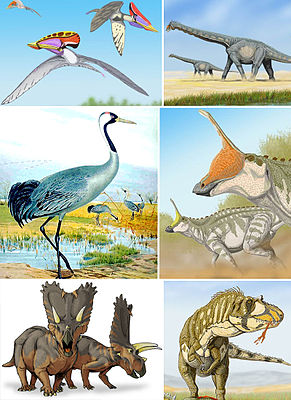Avemetatarsalia
| Avemetatarsalia | ||||||||||||
|---|---|---|---|---|---|---|---|---|---|---|---|---|

Various members of the Avemetatarsalia, clockwise from top left: Tupuxuara , Alamosaurus , Tsintaosaurus , Daspletosaurus , Pentaceratops , crane ( Grus grus ). |
||||||||||||
| Temporal occurrence | ||||||||||||
| Middle Triassic to this day | ||||||||||||
| 237 to 0 million years | ||||||||||||
| Locations | ||||||||||||
|
||||||||||||
| Systematics | ||||||||||||
|
||||||||||||
| Scientific name | ||||||||||||
| Avemetatarsalia | ||||||||||||
| Benton , 1999 |
Avemetatarsalia is the name for a clade of archosaurs . This is defined as a stem-based taxon that includes all Avesuchia ( crown group archosauria), which are more closely related to the dinosaurs than to the crocodiles .
etymology
The name Avemetatarsalia is made up of the Latin word avis for "bird" and the word metatarsus , the anatomical term for the metatarsus (area between the tarsus and toes). It refers to the bird-like structure of the metatarsus as a common feature of the group and was coined by Michael Benton in 1999.
features
The cervical spine is curved in an S-shape, as is still the case in birds today. The typical construction of the ankle is another characteristic of the group. The joint is between the "upper" (proximal) tarsal bones astragalus and calcaneus, which are closer to the knee, and the "lower" (distal) tarsal bones, which are closer to the tip of the foot. This arrangement, in conjunction with an extension of the foot, allows the animals to move digitigrade (walking on their toes). The sister group of the Avemetatarsalia are the Crocodylotarsi (or Crurotarsi), consisting of some extinct taxa such as the Phytosauria as well as the more recent crocodiles , in which the ankle is located between astragalus and calcaneus, which allows their representatives to occur with the entire sole of the foot.
The name for the avemetatarsalia is derived from the structure of the metatarsus, which is strongly reminiscent of the tarsal-metatarsal complex (tarsometatarsus) of today's birds. The foot is very compact here, because the metatarsals I to IV are not yet fused with each other and with the tarsus, as in birds, but they are snuggled together. In addition, the metatarsus is very long: the length of the metatarsal bones II-IV is more than 50% of the length of the shinbone (tibia). In addition, the avemetatarsalia are characterized by the absence of dorsal osteoderms (only reappeared in some groups of dinosaurs).
Systematics

The Avemetatarsalia belong to the Archosaurs . The sister taxon are the Crurotarsi . Cladogram according to Benton (2007), "Archosauria" refers to a clade that includes purely fossil groups and is alternatively called "Archosauriformes". "Avesuchia" refers to the crown archosaurs:
| Archosauria |
|
||||||||||||||||||||||||
|
|
The Avemetatarsalia are divided into two taxa: The basal genus Scleromochlus and the highly diverse group Ornithodira . The Ornithodira in turn are divided into the Pterosauromorpha ( pterosaurs i. W. S.) and the Dinosauromorpha (dinosaurs i. W. S.). Cladogram according to Ezcurra (2006):
| Avemetatarsalia |
|
|||||||||||||||||||||||||||||||||||||||||||||||||||||||||||||||
|
|
In some relationship analyzes of the basal archosaurs it came out that Scleromochlus is not the sister taxon of the Ornithodira, but the sister taxon of all pterosaurs. In this case, the names "Ornithodira" and "Avemetatarsalia" refer to the same clade.
Individual evidence
- ↑ a b Michael J. Benton: Scleromochlus taylori and the origin of dinosaurs and pterosaurs. In: Philosophical Transactions of the Royal Society. Series B: Biological Sciences. Vol. 354, No. 1388, 1999, pp. 1423-1446, doi : 10.1098 / rstb.1999.0489 .
- ^ A b Michael J. Benton: Origin and relationships of Dinosauria. In: David B. Weishampel , Peter Dodson , Halszka Osmólska (eds.): The Dinosauria . 2nd Edition. University of California Press, Berkeley CA et al. 2004, ISBN 0-520-24209-2 , pp. 7-19.
- ↑ a b Michael J. Benton: Paleontology of the vertebrates. Translation of the 3rd English edition by Hans-Ulrich Pfretzschner. Pfeil, Munich 2007, ISBN 978-3-89937-072-0 .